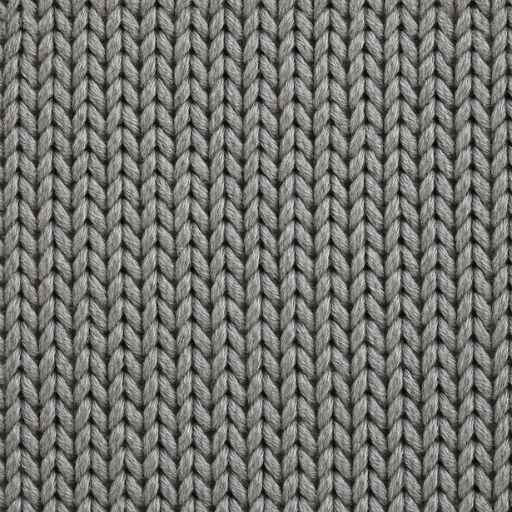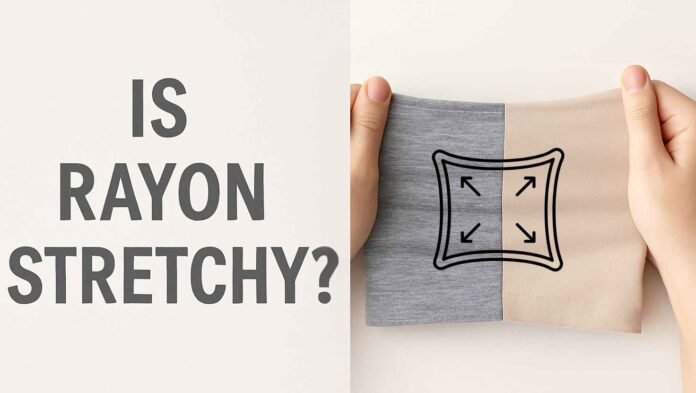Rayon is a kind of semi-synthetic fiber made from wood pulp known for its softness, lightweight feel, and graceful drape in garments like dresses and blouses. To answer the question, “is rayon stretchy”? This article examines the stretch properties of rayon. We will look at pure rayon and discuss its comparison to other fabrics, how blends and weaves impact stretch, and tips on how to make rayon fabrics more stretchy.
Is Rayon Naturally Stretchy?
Plain woven rayon fabrics and pure rayon fibers exhibit minimal stretch. Rayon lacks inherent elastic fibers which limits its ability to stretch significantly when tension is applied to simple rayon fabric. Textile specialists describe rayon as having moderate stretchability which nevertheless does not match the stretch performance of spandex.
Spandex which is also identified as Lycra or elastane achieves worldwide recognition because it stretches up to five times its initial length. Any clothing piece containing even a minimal amount of spandex will demonstrate much greater stretchability than garments made from 100% rayon. Rayon offers softer draping properties and smoother texture than cotton. Neither cotton nor rayon possesses substantial natural stretchiness. Cotton materials have no natural stretch and therefore display limited elasticity. Rayon exhibits slightly more flexibility than cotton enabling it to drape on the body in a flattering manner yet it remains non-stretchy without additional treatment. Manufacturers achieve stretch in rayon fabrics by adding a small amount of spandex or elastane. A rayon blend gains substantial flexibility when manufacturers include about 5–10% spandex.
Factors Affecting Rayon’s Stretchiness
The stretch capability of rayon fabric depends on multiple different factors.

The weave or knit structure is crucial. Rayon produced in jersey knit construction yields some stretch since knitted loops create inherent stretch through their interlocking connections. The plain woven rayon fabric which has warp threads running perpendicular to weft threads displays minimal stretch along its grain. Knit fabrics have significantly greater stretch potential compared to woven fabrics. Jersey-knit rayon stretches in multiple directions while straight-grain woven rayon resists stretching.
Another key factor is fabric blend. The typical method for giving rayon stretch properties involves blending it with either spandex or elastane. A minimal addition of stretch fiber results in significant fabric elasticity. Textile specialists explain that incorporating 10% elastane into synthetic materials results in almost twice the stretch capability. The same holds true with rayon blends: A fabric blend of rayon-spandex knit with approximately 5% elastane delivers greater stretchability compared to pure rayon. Blends are expressed on fabric labels as “95% rayon, 5% spandex” or “rayon-spandex jersey” to show the material’s stretchy rayon knit properties.
The way fabric stretches can also depend on the specific treatments applied to the fabric and the maintenance practices employed afterwards. Rayon will contract when subjected to heat and moisture exposure. The correct finishing techniques like heat-setting and sanforizing stabilize rayon but incorrect treatment during washing may cause it to shrink slightly instead of extending.
As you wear a rayon garment and break it in gently over time the fibers relax slightly which results in a looser fit. Rayon garments experience little mechanical stretching during production or after purchase because their stretchability primarily results from knit structure and embedded elastic fiber.

Rayon vs. Other Stretchy Fabrics
Rayon’s stretch performance compared to popular fibers:
| Fabric | Stretchiness | Notes |
| Rayon (Viscose) | Low to moderate | Soft drape and some give, but “far short of [spandex’s] stretch” icefabrics.com. Good for flow, not tight fit. |
| Spandex (Lycra) | Very high | Extremely elastic – can extend ~500% and spring back. Used for maximum stretch-wear (e.g. activewear, leggings). |
| Cotton | Low | Natural fibers lack inherent elasticity, so pure cotton doesn’t stretch much. Knits (cotton jersey) do stretch modestly. |
| Polyester | Moderate (w/blends) | Polyester is slightly more resilient than rayon. Blends (polyester/spandex) can be very stretchy; 10% elastane can double stretch. |
When comparing stretchability spandex clearly outperforms all other materials. Rayon creates better drape compared to cotton while providing a slightly more natural stretch, but neither compares to spandex. Polyester alone has limited elasticity but manufacturers mix it with spandex to enhance its stretchability. The above table demonstrates that only fabrics including built-in elastic fibers such as spandex and very stretchy knits can reach high stretch levels.
How to Make Rayon Stretchy?
For those who have rayon garments or fabric and wish to enhance their stretchiness use these tips.
Choose the right blend: Look for fabrics labeled rayon-spandex or rayon-elastane. A fabric blend containing just 5% spandex achieves remarkable stretchiness. Knit fabrics and jersey-rayon materials provide better natural stretch during sewing compared to woven fabrics.
Wash and wear: Carefully washing rayon may loosen its fibers. Rayon fabrics become slightly relaxed when some sewists wash them using warm water while following care instructions. However, be cautious: rayon also tends to shrink with heat. Use cold water cycles and air-dry to reduce shrinkage.
Stretch while sewing: For sewing rayon knits the seams will remain flexible if you apply zigzag or stretch stitches. The narrow zigzag stitch enables seams to expand along with the fabric. To prevent the fibers from snagging you should use a ballpoint or stretch needle. These sewing techniques maintain the fabric’s stretch while preventing stitches from tearing when the garment stretches.
Bias cutting (for woven): Cutting patterns at a 45° angle from the grain when working with non-stretch woven rayon adds some drape and flexibility to the material. When you cut garments on the bias they achieve greater fluid movement while also exhibiting a subtle stretch along the diagonal.
Fabric relaxers: Home seamstresses sometimes hold a completed rayon garment on a mannequin to steam it and then stretch it gently. This can sometimes temporarily improve drape. Rayon fabric exhibits poor recovery properties which makes over-stretching cause permanent damage to its shape.
Overall, the best approach is prevention: Start with a rayon fabric that has stretch capabilities like knit blends for the best results. Keep rayon garments shaped by choosing knit blends and treating them carefully during maintenance.
Best Uses for Stretchy vs. Non-Stretchy Rayon

- Stretchy Rayon: Rayon fabrics mixed with spandex or elastic fiber knits work well for garments that need to fit close to the body. The ideal uses for stretchy rayon include garments like leggings as well as fitted dresses and stretchy tops together with activewear. The fabric’s slight flexibility enables easy movement. Soft stretchy summer dresses and tops result from many rayon-spandex jersey fabrics. Knit fabric possesses the ability to hug and shape the body while remaining flexible and not stiff.
- Non-Stretchy Rayon: The main strength of pure rayon is its fluid movement and graceful draping. 100% rayon fabrics work best for making blouses with beautiful drape as well as flowing skirts and dresses with loose fits. Rayon’s fluid texture creates elegant silhouettes. Rayon chiffon and crepe blouses demonstrate elegant movement while maintaining their non-clinging properties. Rayon’s “soft, cascading texture” creates perfect material for comfortable flowing garments including blouses and outerwear according to one review. Lightweight rayon materials stay cool and classy yet lack any stretch from elastic fibers.
Select the appropriate rayon, based on the specific garment you are using it for. Stretch garments including leggings and body-skimming dresses require a rayon–spandex knit material. When creating flowy garments such as boho skirts and tunic blouses choose woven rayon to take advantage of its perfect drape. The array of rayon textiles displayed below features stretching knit options through to sheer chiffon-like fabrics that drape softly.
Common Questions About Rayon Stretch
Does rayon stretch over time?
Yes, but only a little. Rayon fibers demonstrate some stretchability when worn regularly which becomes particularly noticeable in knit fabrics. Over time repeated stretching makes rayon lose its ability to snap back to its original shape. Experts caution that stretching rayon garments more than once can diminish their elasticity which stops them from returning to their original shape. Rayon garments that stretch will eventually sag after repeated wear and heavy stretching.
Can you stretch rayon fabric?
Rayon fabrics exhibit temporary stretchability which improves further when blended with elastane fibers. The addition of spandex to rayon makes it stretchable but the fabric does not return well to its original shape. 100% rayon fabric lacks significant stretch properties when spandex is not present. Plain rayon does not have the ability to return to its original state after stretching like spandex does. Although knit rayon fabric stretches when pulled it doesn’t stay extended nor recover its shape well.
Is rayon better than cotton for stretch?
It depends. Both pure cotton and pure rayon fabrics exhibit limited stretching capabilities. Rayon presents a more lenient feel when compared to cotton because of its draping quality, whereas cotton maintains its shape strongly. Neither material shows substantial elasticity without the inclusion of spandex. What matters more is the blend: The main component that determines the elasticity of cotton-spandex and rayon-spandex fabrics is the proportion of elastane present.
Conclusion-
Rayon lacks significant stretchability because it does not stretch much on its own. Pure rayon fabrics display minimal stretch and provide soft drape along with poor shape recovery ability. Adding stretch to rayon requires blending it with elastane (spandex) or knitting it into a looped fabric structure. Improper care can cause rayon fabric to shrink, so handle it gently. When shopping for stretch, check fabric labels: look for rayon blends (e.g. rayon-spandex) or knits. Selecting materials with rayon blends will achieve the desired flexibility in your garment. The selection of rayon fabric based on its type (stretchy knit or flowy weave) determines the compatibility of its properties with the clothing you intend to create or purchase.
Read More>> If you would like to learn about a lightweight, puckered cotton “seersucker fabric” or a natural, breathable textile made from the stalks of the ramie plant, known for its strength, silky luster, and resistance to wrinkles “ramie fabric.“

Thanks for giving your ideas. A very important factor is that learners have an alternative between fed student loan along with a private education loan where it really is easier to select student loan consolidating debts than with the federal student loan.
You made some respectable factors there. I looked on the web for the difficulty and found most individuals will associate with with your website.